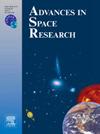人类在月球上的活动产生的临时大气层
IF 2.8
3区 地球科学
Q2 ASTRONOMY & ASTROPHYSICS
引用次数: 0
摘要
无论是月球飞行器的上升/下降阶段,还是气闸减压、漫游车或宇航服的排气,都可能在月球表面和外大气层造成不必要的挥发物积累。这在月球两极永久阴影区(或其附近)尤为重要。在此,我们对人类在月球上的各种着陆物体(包括背包、气闸、漫游车、着陆器、垃圾和采矿作业)的预期排气量进行了估算。宇航服会产生一定程度的氧气放气(Helou 等人,2022 年),这些氧气可能会在这些 PSR 中传输和冷凝,甚至在微冷捕集器中传输和冷凝(Glavin 等人,2010 年)。这些放气系统可在来源附近(半径∼100 公里)形成局部的临时大气。在辐射源数米范围内,大气可能会特别高。为了获得这些临时大气的柱密度,我们首先为气体数量损失随时间变化的范围设置括号。然后,假定分子是在天体表面温度下从天体表面喷射出来的,我们就可以得出一次弹道跳跃的最大飞行距离和释放的分子在外层大气中停留的时间。在某些情况下,例如宇航员背包和漫游车,温度就是源的温度。根据这些信息,可以估算出当地外大气层的平均密度和峰值密度以及柱密度。我们发现,背包、气闸释放器和星舰着陆器可以产生密度相对较高的局部大气,着陆器附近的局部排气水密度超过 10/cm。这种局部水外大气比 LADEE 得出的自然水外大气下限 ∼3/cm 大 10 倍以上。因此,人为的临时水外大气层很可能在着陆器附近的环境中占主导地位,从而难以对自然外大气层的水环境进行评估。本文章由计算机程序翻译,如有差异,请以英文原文为准。
Temporary atmospheres produced by human activities on the Moon
Outgassing from materials, whether through the ascent/descent stages of lunar vehicles, airlock depressurizing, rover or astronaut suit outgassing, may cause an effect of unwanted accumulation of volatiles at the surface and exosphere. This is especially important at (or proximal) to permanently shadowed regions (PSRs) at the lunar poles. Herein, we provide estimates of expected outgassing from various human-landed objects on the Moon, including backpacks, airlocks, rovers, landers, trash and mining operations. Astronaut suits produce some level of oxygen outgassing (Helou et al., 2022), which may transport and condense in these PSRs, even in micro- cold traps (Glavin et al., 2010).We estimate the outgassing from drill mining and trash-to-gas conversion assuming a specific technology is operating. These outgassing systems can create local, temporary atmospheres in the vicinity (∼100 km radius) of the sources. The atmosphere may be particularly high within meters of the source. To obtain column densities for these temporary atmospheres, we first bracket ranges for the gas number loss as a function of time. We then derive the maximum distance traveled and the time the released molecules remain in the exosphere for a single ballistic hop, assuming the molecules are ejected from the surface of the object at its surface temperature. In some cases, such as the astronaut backpack and the rover, the temperature is that of the source. Given this information, an average and peak local exospheric density and column density can be estimated. We find that backpacks, airlock releases, and the Starship lander can create relatively high-density local atmospheres, with local near-lander outgassing water densities exceeding 107/cm3. This local water exosphere is over 106 times greater than the LADEE-derived lower limit of the natural water exosphere at ∼3/cm3. Thus, the anthropogenic temporary water exosphere will likely dominate the environment near the lander, making an assessment of the natural exospheric water environment difficult.
求助全文
通过发布文献求助,成功后即可免费获取论文全文。
去求助
来源期刊

Advances in Space Research
地学天文-地球科学综合
CiteScore
5.20
自引率
11.50%
发文量
800
审稿时长
5.8 months
期刊介绍:
The COSPAR publication Advances in Space Research (ASR) is an open journal covering all areas of space research including: space studies of the Earth''s surface, meteorology, climate, the Earth-Moon system, planets and small bodies of the solar system, upper atmospheres, ionospheres and magnetospheres of the Earth and planets including reference atmospheres, space plasmas in the solar system, astrophysics from space, materials sciences in space, fundamental physics in space, space debris, space weather, Earth observations of space phenomena, etc.
NB: Please note that manuscripts related to life sciences as related to space are no more accepted for submission to Advances in Space Research. Such manuscripts should now be submitted to the new COSPAR Journal Life Sciences in Space Research (LSSR).
All submissions are reviewed by two scientists in the field. COSPAR is an interdisciplinary scientific organization concerned with the progress of space research on an international scale. Operating under the rules of ICSU, COSPAR ignores political considerations and considers all questions solely from the scientific viewpoint.
 求助内容:
求助内容: 应助结果提醒方式:
应助结果提醒方式:


